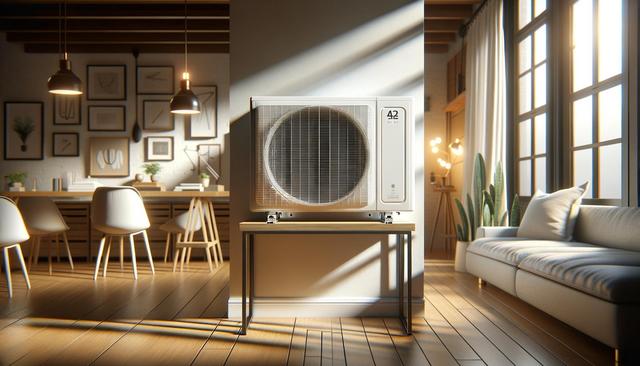What Is Ductless Air Conditioning?
Ductless air conditioning, also known as a mini-split system, is a type of cooling solution that operates without the need for traditional ductwork. It consists of two main components: an outdoor compressor/condenser and one or more indoor air-handling units. These indoor units are typically mounted on walls and are connected to the outdoor unit via a small conduit that houses the power cable, refrigerant tubing, and a drain line. This setup enables homeowners and businesses to cool specific areas directly without relying on a centralized air system. Ductless AC systems are especially appealing for older homes, room additions, or buildings where installing ductwork would be complex or cost-prohibitive.
Unlike central air systems, ductless options offer targeted cooling, making them highly efficient and flexible for a wide range of applications. Because they don’t require ducts, there’s no energy loss due to air leaks — a common issue in traditional ducted systems. This makes ductless air conditioning a practical and energy-conscious choice for many households.
Energy Efficiency and Cost Savings
One of the most attractive benefits of ductless air conditioning is its energy efficiency. Traditional central systems can lose up to 30% of their energy through ducts, especially if those ducts are located in unconditioned spaces like attics. Ductless systems eliminate this issue entirely, helping homeowners reduce their energy consumption and, as a result, their utility bills. Most ductless units also come equipped with inverter-driven compressors that adjust their speed based on the cooling demand rather than shutting off and on repeatedly. This further enhances energy efficiency and provides more stable indoor temperatures.
Here are some ways ductless AC systems can help save costs in the long run:
- Reduced energy loss due to the absence of ductwork
- Zoned cooling means you only cool the rooms you use
- Lower maintenance expenses due to fewer components
- Potential eligibility for tax credits or utility rebates
Although the upfront cost might be higher than some conventional systems, the long-term savings often make ductless AC a worthwhile investment for many property owners.
Flexible Installation Options
Ductless air conditioning offers impressive flexibility in terms of installation. Since there’s no need to run ductwork throughout a building, installation is typically quicker and less invasive. This makes ductless systems an excellent option for retrofitting older homes, updating underused spaces like garages or basements, or adding climate control to new room additions without altering the entire HVAC system.
Installers can mount indoor units in various positions to suit the layout and aesthetics of a room. Common options include:
- Wall-mounted units, which are ideal for most spaces
- Ceiling cassette units, which are discreet and effective for larger areas
- Floor-mounted units, suitable for areas with limited wall space
Most systems can support multiple indoor units connected to a single outdoor compressor, allowing for customizable climate zones throughout a building.
Improved Indoor Air Quality
Ductless air conditioning systems can also contribute to better indoor air quality. Traditional ducted systems can harbor dust, allergens, and even mold if not cleaned regularly. These contaminants can circulate throughout the home, negatively affecting air quality. Because ductless systems do not use ductwork, there is less opportunity for pollutants to spread. Furthermore, many ductless units are equipped with multi-stage filtration systems that capture fine particles, bacteria, and odors.
Improved air quality is especially beneficial for households with:
- Allergy sufferers
- Individuals with asthma or respiratory conditions
- Homes with pets that shed dander or hair
Maintaining the filters is typically straightforward. Most ductless units have washable filters that are easy to access and clean, making it simple for users to maintain optimal performance and indoor air quality over time.
Zone-Based Comfort and Control
Another significant advantage of ductless air conditioning is its ability to provide zoned comfort. Each indoor unit can be operated independently, allowing users to set different temperatures in different rooms or zones. This level of control is ideal for households with varying comfort preferences or for homes with rooms that see different levels of use throughout the day.
Benefits of zoned cooling include:
- Enhanced comfort for occupants in different rooms
- Energy savings by not cooling unused spaces
- Greater control over indoor environment and temperature
Many ductless systems also come with remote controls or smart technology features, enabling users to adjust settings from a smartphone or tablet. This makes it easier to manage energy use and maintain consistent comfort throughout the home.
Conclusion: A Smart Choice for Modern Living
Ductless air conditioning offers a modern, efficient, and flexible solution for a wide range of cooling needs. Whether you’re upgrading an older home, remodeling a specific space, or simply looking for a more energy-conscious way to stay comfortable, ductless systems provide numerous advantages. From improved air quality and zoned comfort to lower energy bills and streamlined installation, it’s clear why more homeowners and businesses are considering this approach. If your space lacks ductwork or you’re seeking a more targeted and efficient cooling method, ductless air conditioning is definitely worth exploring.




Leave a Reply